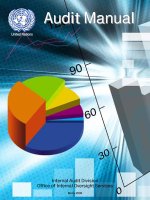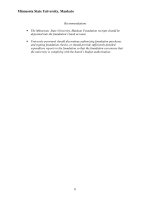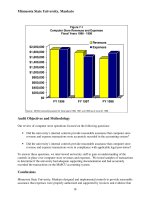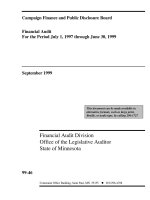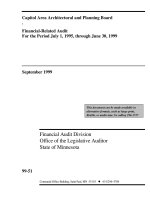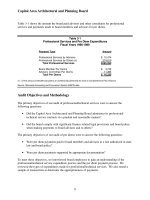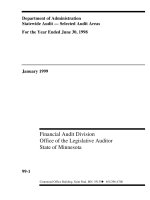Central Lakes College Financial Audit For the Period July 1, 1995, through June 30, 1998 May 1999 Financial Audit Division Office of the Legislative Auditor State of Minnesota_part2 pdf
Bạn đang xem bản rút gọn của tài liệu. Xem và tải ngay bản đầy đủ của tài liệu tại đây (42.03 KB, 10 trang )
Central Lakes College
7
Chapter 3. Tuition, Fees, and Other Receipts
Chapter Conclusions
We noted internal control weaknesses in various receipt areas. The college did
not promptly record or deposit customized training receipts timely. The college
had inadequate separation of duties for staff in certain areas of the revenue
process.
Central Lakes College collected tuition and fees each quarter from students enrolled in campus
programs. The college used the Collegiate Information System (CIS) to register, bill, and collect
tuition receipts. The resident tuition rate was $40 plus fees for fiscal year 1996, $41.60 plus fees
in fiscal year 1997, and $42.65 plus fees in fiscal year 1998.
Tuition, fees, and non-credit tuition revenue for fiscal years 1996 to 1998 are shown in
Table 3-1.
Table 3-1
Tuition Revenue
Fiscal Years 1996, 1997, and 1998
Revenue Source 1996 1997 1998
Tuition $5,009,667 $4,903,905 $5,106,071
Fees 614,413 749,312 720,006
Non-credit tuition 551,212 626,324 439,662
Total $6,175,292 $6,279,540 $6,265,739
Source: MnSCU to MAPS Trial Balance as of February 8, 1999.
Along with traditional community and technical college courses, Central Lakes College also
offered various specialized programs. The continuing education program provided consultation
and educational services to businesses, public institutions, and non-profit organizations in central
Minnesota. Non-credit offerings ranged from computer systems training to heavy machinery.
The Farm Business Management (FBM) and Small Business Management (SBM) programs
provided courses in business and farm management at off campus sites. In addition, the college
collected other receipts for student activities and vending commissions.
Audit Objectives and Methodology
We focused our review of tuition, fees, and other revenue on the following questions:
• Did the college design and implement internal controls to provide reasonable assurance
that revenue collections were safeguarded, accurately reported in the accounting records,
and in compliance with applicable legal provisions and management’s authorization?
Central Lakes College
8
• For the items tested, did the college comply, in all material respects, with the significant
finance-related legal provisions governing tuition?
To answer these questions, we interviewed college employees to gain an understanding of the
internal controls over the billing, collecting, and recording of tuition, fees, and other revenue.
We determined the reasonableness of tuition revenue recorded on the MnSCU accounting system
in relation to the recorded credits on CIS. We reviewed the tuition and fees collected by the
customized training centers. We also tested transactions to determine the timeliness of deposits
and recording of revenue on the MnSCU accounting system.
Conclusions
We noted internal control weaknesses in various receipt areas. The college did not promptly
record or deposit customized training receipts timely. The college had inadequate separation of
duties for staff in certain areas of the revenue process. Findings 5 through 8 discuss these issues.
5. PRIOR FINDING PARTIALLY RESOLVED: Central Lakes College did not
promptly deposit tuition and customized training receipts with the state treasury, as
required by statutory provisions.
The college’s delays in posting tuition receipts on the MnSCU accounting system resulted in
untimely transfers of the tuition receipts from its local account to the state treasury. Although
the college deposited its tuition receipts into its local bank account each day, it posted those
deposits to the MnSCU accounting system only three to four times per month. Sometimes the
college did not post the receipts to the MnSCU accounting system until up to a month after the
deposit. The college’s posting of the deposit to the MnSCU accounting system initiates the
transfer to the state treasury account. Until the posting occurs, the deposited tuition receipts
remain in the college’s local account. Minn. Stat. Section 16A.275 requires that the college
deposit receipts exceeding $250 daily with the state treasury. During fiscal year 1998 and more
recently, the college shortened, but did not eliminate the delay between the deposit of the
receipts into the local bank account and the posting on MnSCU accounting.
In addition, Central Lakes College did not promptly deposit customized training receipts. The
college held customized training tuition receipts while it determined whether it would hold or
cancel the class. The college did this so it could return the unendorsed checks to the class
registrants if it cancelled the class. If the college did not cancel the class, it prepared the deposit
and took the receipts to the bank. In October 1998, the college directed its customized training
office to discontinue its practice of holding checks and to deposit its receipts daily.
Recommendation
• The college should deposit receipts totaling $250 or more on a daily basis and
promptly record those deposits on the MnSCU accounting system to allow for
their timely transfer to the state treasury account.
Central Lakes College
9
6. PRIOR AUDIT FINDING SUBSTANTIALLY RESOLVED: The college did not
adequately separate duties over the collection of customized training receipts and the
billing of third party funding.
The college did not adequately segregate duties related to customized training receipts. The staff
in the customized training centers registered students, collected receipts, and prepared the daily
deposits. These duties are incompatible since staff could change the registration data to hide a
misappropriation of tuition funds. Colleges often prevent this weakness in the control system by
separating the registration function from the cashiering function. For example, the college could
send receipts directly to the business office.
We also found inadequate separation of duties over the billing process for third party funding.
One individual in the business office was responsible for billing the companies, collecting the
receipts, and posting to accounts receivable. Concentrating the billing and collection
responsibilities creates an environment where an employee could misappropriate receipts and
adjust the billing records to reflect the payment without detection.
Recommendations
• The college should establish an adequate separation of duties over the
customized training registration and cashiering responsibilities.
• The college should establish an adequate separation of duties over the billing,
collection, and accounts receivable responsibilities.
7. Central Lakes College did not adequately safeguard tuition and fee revenues.
During our audit, we observed that the Staples Customized Training Center did not restrictively
endorse checks until it prepared the deposit. Restrictively endorsing checks when received
reduces the risk of a lost or stolen check being cashed.
We also found that the college did not provide adequate security for employees and receipts in
transit between the college and the bank. Without adequate safeguards, employee safety and the
security of deposits are at risk.
Recommendations
• The college should restrictively endorse checks when received.
• The college should review the options for providing security for employees
and cash when in transit between the college and the bank.
8. The college did not monitor tuition administrative adjustments.
Central Lakes College did not verify the propriety of tuition administrative adjustments. Some
employees in the business office had access to cash and the authority to perform refunds and
administrative adjustments. Administrative adjustments allow the employees to make changes to
student account receivable records. Employees are required to perform adjustments on a
specified terminal and the transactions are logged by user ID. However, the weekly report listing
Central Lakes College
10
all administrative adjustments is not independently reviewed. The lack of an independent review
increases the risk of errors or irregularities occurring and going undetected.
Recommendation
• The college should independently review administrative adjustments.
Central Lakes College
11
Chapter 4. Payroll
Chapter Conclusions
Central Lakes College designed and implemented internal controls to provide
reasonable assurance that payroll expenditures were accurately reported in the
accounting records and in compliance with applicable legal provisions and
management’s authorization. For the items tested, the institution complied, in
all material respects, with the significant finance-related legal provisions
concerning payroll. However, the college did not adequately separate personnel
and payroll functions and did not provide unique logon identification access to
the payroll system. The college also did not consistently conduct annual
employee evaluations.
Central Lakes College employed approximately 346 staff during fiscal year 1998, including 139
full-time and 81 part-time faculty and 126 non-faculty personnel. Payroll expenditures totaled
approximately $14 million for fiscal year 1998. Employees at Central Lakes College are
members of the following compensation plans:
• American Federation of State and County Municipal Employees (AFSCME),
• United Technical College Educators Plan (UTCE),
• Minnesota Community College Faculty Association (MCCFA),
• Middle Management Association (MMA),
• Minnesota Association of Professional Employees (MAPE),
• Commissioner’s Plan,
• Managerial Plan,
• Master Agreement between Minnesota State Colleges and Universities Board of Trustees
and United Technical College Educators and Unrepresented Bargaining Unit (UNR), and
• Excluded Administrators.
During fiscal year 1996, the college used the state’s personnel/payroll system (PPS) and the State
Colleges and Universities Personnel/Payroll System (SCUPPS) to process payroll information.
SCUPPS stored pay rate information and bargaining agreement history. The PPS contained pay
rate information and calculated employee biweekly payments. The college converted from PPS
to the state’s new SEMA4 payroll system in November 1996.
Central Lakes College had a human resources and payroll department located in Brainerd. The
human resources offices updated SCUPPS appointments and salaries. The payroll office
collected employee timesheets for update of SEMA4 mass time entry and was responsible for
ensuring proper recording of payroll expenditures in MnSCU accounting. The college began to
input its own payroll in November of 1996.
Central Lakes College
12
Audit Objectives and Methodology
Our review focused on the following objective:
• Did Central Lakes College design and implement internal controls to provide reasonable
assurance that payroll expenditures were accurately reported in the accounting records
and in compliance with applicable legal provisions and management’s authorization?
• For the items tested, did the college comply, in all material respects, with the significant
finance-related legal provisions concerning payroll?
To answer these questions, we made inquiries of college staff to gain an understanding of the
internal control structure over the payroll and personnel process. We analyzed payroll
expenditures to determine proper recording of payroll transactions, reviewed source documents
to determine proper authorization, and tested salaries to ensure proper payment pursuant to
contract provisions.
Conclusions
Central Lakes College designed and implemented internal controls to provide reasonable
assurance that payroll expenditures were accurately reported in the accounting records and in
compliance with applicable legal provisions and management’s authorization. For the items
tested, the institution complied, in all material respects, with the significant finance-related legal
provisions concerning payroll. The college did not appropriately separate human resource duties
and did not provide unique logon identification access into the payroll system. The college also
did not consistently conduct annual employee evaluations.
9. The college did not adequately separate personnel and payroll functions.
Central Lakes College did not separate the personnel and payroll functions. The college had one
employee assigned to enter timesheets into the payroll system. If this individual was not
available, someone from the personnel office would enter the timesheet data into the payroll
system. Access to both SCUPPS and SEMA4 could permit an employee to make unauthorized
personnel changes to SCUPPS and use those transactions to generate improper payroll
transactions in SEMA4. Also, the employee from the personnel office used the payroll
employee’s logon ID and password to access the state’s payroll system. In order to prevent
errors and irregularities from occurring, the college should separate the personnel and payroll
data entry functions and assign unique user IDs to staff.
Recommendations
• Central Lakes College should provide someone who is not an employee in
human resources as a backup for timesheet data entry.
• The college should not allow staff to share logon IDs.
Central Lakes College
13
10. Central Lakes College did not consistently conduct annual evaluations.
Central Lakes College did not consistently conduct annual evaluations of all of its employees
during the three years included within our audit scope. We found that 16 of the 22 employees
tested did not have current annual evaluations. Some compensation plans require annual
evaluations, while others may require that employee increases be based upon satisfactory
progress as shown on their evaluations. Central Lakes College should conduct annual
evaluations to advise employees of the quality of their work and to provide the college with a
basis for employee raises and promotions.
Recommendation
• The college should conduct annual employee performance evaluations.
Central Lakes College
14
This page intentionally left blank.
Central Lakes College
15
Chapter 5. Student Financial Aid
Chapter Conclusions
Central Lakes College designed and implemented internal controls to provide
reasonable assurance that financial transactions were properly recorded in the
accounting system, accurately reported to the federal government, and
administered in accordance with applicable federal regulations. Central Lakes
College also complied with applicable federal requirements over receiving
federal funds, and designed internal controls over packaging and awarding
federal financial aid to provide reasonable assurance that only eligible students
received aid in the appropriate amounts. However, we found that the college
did not restrict access to financial aid checks. In addition, the college did not
separate the work-study payroll input and disbursing functions.
The Central Lakes College participated in several federal student financial aid programs
administered by the U.S. Department of Education. Table 5-1 summarizes program expenditures
for fiscal year 1998.
Table 5-1
Federal Financial Aid Expenditures
Fiscal Year 1998
CFDA
Number Program
Total
Expenditures
84.032 Federal Family Loan (FFEL) $2,501,180
84.063 Federal PELL Grant 1,788,146
84.007 Federal Supplemental Educational
Opportunity Grant (FSEOG)
159,800
84.033 Federal Work-Study (FWS) 207,589
Note: SEOG and Federal Work-Study expenditures include both the federal and state share.
Source: Auditor prepared based on information provided by Central Lakes College.
Central Lakes College used an automated financial aid system called SAFE to determine a
student’s financial need and identify the financial aid options available to that student. SAFE
automatically allocated PELL grants, FSEOG, and Minnesota State grants to eligible students.
After the system determined these awards, the college determined the student’s eligibility for
FFEL loans and college work-study. The college posted financial aid award information to the
student registration system, adjusting awards as needed based upon a student’s actual enrollment
status after the drop/add period for the term. The Financial Aid Office credited student financial
Central Lakes College
16
aid awards to the student’s tuition receivable account. The business office generated checks to
the students for any aid in excess of the tuition and fees owed the college.
Following are descriptions of the material federal and state financial aid programs:
• The Federal PELL Grant was generally the first source of financial assistance to an
eligible student. SAFE determined the Federal PELL Grant awards using the cost of
attendance and the expected family contribution. The U.S. Department of Education
provided Federal PELL Grant funds to each campus based on the enrollment of eligible
students.
• Under the Federal Family Education Loan Program, private lenders provided the loan
principal, and the federal government guaranteed the loan in the event of default or
cancellation. For subsidized Stafford loans, the federal government paid interest to the
lender while the student was in school and during certain deferment periods. For
unsubsidized Stafford loans, the student paid all interest that accrued on the loan.
• Federal Supplemental Educational Opportunity Grants were awarded to exceptionally
needy undergraduate students. SAFE determined a student's need based on the cost of
attendance budget and the expected family contribution. The U.S. Department of
Education funded 75 percent of the Federal Supplemental Educational Opportunity
Grants and the college funded the remainder.
• The Federal Work-Study program provided part-time employment for students who
continued to have financial need after receiving all available grants. Like FSEOG, the
U.S. Department of Education funded 75 percent of the Federal Work-Study Program and
the college funded the remainder.
• The college also participated in the Minnesota State Grant program, which is funded by
the Minnesota Higher Education Services Office. Eligible students must register and
attend classes for fifteen credits to receive their full grant award. In fiscal year 1998, the
college disbursed $1,106,636 of the Minnesota State Grants.
Audit Objectives and Methodology
The primary objectives of our audit were to answer the following questions:
• Did the college design and implement internal controls to provide reasonable assurance
that financial transactions for student financial aid were properly recorded in the
accounting system, accurately reported to the federal government, and administered in
accordance with applicable federal regulations?
• Did the college comply with applicable legal requirements over receiving federal funds?
• Did the college design and implement internal controls over packaging and awarding
federal financial aid to provide reasonable assurance that only eligible students received
aid in the appropriate amounts?
